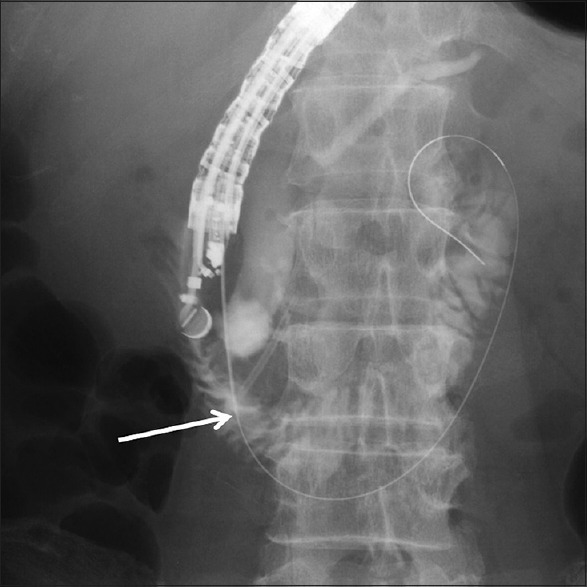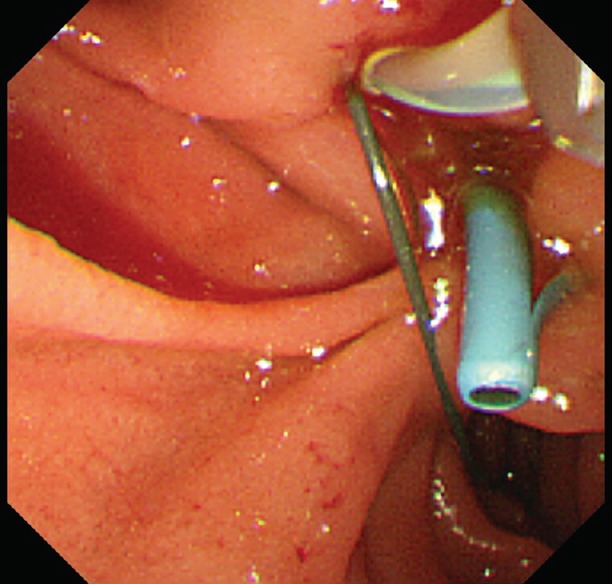Endoscopic ultrasound-guided rendezvous technique (EUS-RV) is one of the salvage methods for biliary access after failed endoscopic retrograde cholangiopancreatography (ERCP).[1] The technical success rate is reported to be around 80%.[2] The most frequent reason for the failure is inability to manipulate a guidewire across the stricture or the papilla through the needle.[3] To avoid severe complications such as biliary peritonitis, the development of a salvage therapy is mandatory. We report a patient who underwent a modified EUS-RV after failed guidewire manipulation through the ampulla.
A 62-year-old male was admitted for acute cholangitis due to the bile duct cancer. We performed ERCP for biliary drainage, but biliary cannulation failed. Precut sphincterotomy did not open the biliary orifice, so EUS-RV was planned for biliary access. A linear echoendoscope (UCT260, Olympus, Japan) was advanced into the duodenum and the distal bile duct was visualized with a short endoscopic position. After successful puncture of the bile duct, a guidewire could not pass through the papilla. Thereafter, the ampulla was directly punctured toward the duodenal lumen under EUS guidance followed by guidewire insertion to the duodenum [Figure 1]. Following echoendoscope removal, duodenoscopy showed that the guidewire passed through the periampullary area just apart from the pancreatic orifice. Then, the biliary access was obtained by catheter insertion alongside the guidewire [Figure 2] and endoscopic nasobiliary drainage was successfully performed.
Figure 1.

X-ray image showing that the needle is passing through the papilla. The needle tip (arrow) was located inside the duodenal lumen
Figure 2.

Duodenoscopic image showing that the guidewire was passing through the periampullary region apart from the pancreatic orifice where the pancreatic stent was placed
EUS-RV comprises 3 different approach routes; transgastric-hepatic, transduodenal with a long endoscopic position, and transduodenal with a short endoscopic position.[4] There are still scanty evidences about which approach route is the most appropriate.[2] One recent study suggested that a transduodenal route with a short endoscopic position is the most reliable EUS-RV for biliary access.[5] However, the further large study is necessary to validate this data. We, for the first time, reported a modified EUS-RV method after failed conventional transduodenal EUS-RV with a short endoscopic position. This method could be a salvage therapy after conventional EUS-RV failed to pass a guidewire through the papilla.
Financial support and sponsorship
Nil.
Conflicts of interest
There are no conflicts of interest.
REFERENCES
- 1.Kawakubo K, Kawakami H, Kuwatani M, et al. Recent advances in endoscopic ultrasonography-guided biliary interventions. World J Gastroenterol. 2015;21:9494–502. doi: 10.3748/wjg.v21.i32.9494. [DOI] [PMC free article] [PubMed] [Google Scholar]
- 2.Iwashita T, Doi S, Yasuda I. Endoscopic ultrasound-guided biliary drainage: A review. Clin J Gastroenterol. 2014;7:94–102. doi: 10.1007/s12328-014-0467-5. [DOI] [PMC free article] [PubMed] [Google Scholar]
- 3.Iwashita T, Lee JG, Shinoura S, et al. Endoscopic ultrasound-guided rendezvous for biliary access after failed cannulation. Endoscopy. 2012;44:60–5. doi: 10.1055/s-0030-1256871. [DOI] [PubMed] [Google Scholar]
- 4.Kawakubo K, Isayama H, Sasahira N, et al. Clinical utility of an endoscopic ultrasound-guided rendezvous technique via various approach routes. Surg Endosc. 2013;27:3437–43. doi: 10.1007/s00464-013-2896-5. [DOI] [PubMed] [Google Scholar]
- 5.Iwashita T, Yasuda I, Mukai T, et al. EUS-guided rendezvous for difficult biliary cannulation using a standardized algorithm: A multicenter prospective pilot study (with videos) Gastrointest Endosc. 2016;83:394–400. doi: 10.1016/j.gie.2015.04.043. [DOI] [PubMed] [Google Scholar]


